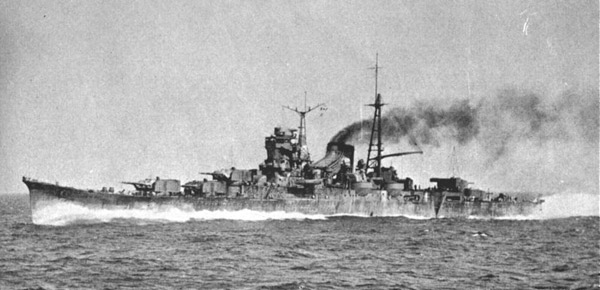Mogami-class
Summary
| Origin country | 🇯🇵 Japan |
| Category | Cruiser |
| Subtype | Heavy cruiser (World War II) |
| Manufacturer | Kure Naval Arsenal, Mitsubishi Shipyard, Nagasaki, Yokosuka Navy Yard , Kawasaki Shipyard, Kobe |
| Year commissioned | 1935 |
| Current operators | 🇯🇵 Japan |
Description
The Mogami class consisted of four cruisers constructed for the Imperial Japanese Navy (IJN) in the 1930s, initially under the constraints of the London Naval Treaty as light cruisers. However, Japan later reneged on the treaty and refitted the ships with larger guns, thus reclassifying them as heavy cruisers. All four ships saw service during World War II and were ultimately destroyed.
These cruisers were part of the Japanese efforts to expand their naval capabilities as per the 1931 Fleet Replenishment Program. They were equipped with innovative 155 mm guns mounted in five triple turrets, allowing for dual-purpose use, both as standard artillery and for anti-aircraft defense. Unique to the IJN, they also incorporated reloadable torpedo launchers. To conform to treaty weight limitations while ensuring robustness, lighter materials such as aluminum were used in the superstructure, and a limited number of boilers were installed to save weight. Designers also paid close attention to the arrangement and integration of funnels to keep weights in check. Despite these efforts, the actual displacement of the Mogami cruisers was understated; the British expressed skepticism at the publicly announced figures. In practice, the cruisers suffered from stability issues and hull fractures, which prompted further modifications including the addition of hull bulges, consequently increasing beam and displacement and reducing speed.
After withdrawing from international naval treaties, Japan upgraded the Mogami class by substituting the original triple 155 mm turrets with twin 203 mm guns, transforming them into heavy cruisers. This rearmament also included the installation of torpedo bulges, further increasing displacement and modifying their overall capabilities.
The operational history of the Mogami class was marked by active combat during the Second World War. They participated in the invasion of the Dutch East Indies and the Battle of Sunda Strait, achieving notable victories. At the Battle of Midway, the class faced a difficult engagement—the Mogami and Mikuma collided and subsequent air attacks from U.S. forces sunk the Mikuma. The damaged Mogami underwent significant reconstruction, including a transformed aft section with a flight deck. Ultimately, the remaining ships faced their demise at the Battle of Leyte Gulf, where they encountered crippling damage and were scuttled to avoid capture by enemy forces.
The Mogami class cruisers played an important role in naval warfare and influenced the design of contemporaneous ships, such as the United States Navy's Brooklyn-class cruisers, which were specifically intended to counter the threat posed by the Mogami class.
Technical specifications
| Displacement | 13670 tons |
| Range | 14000 km at 14 knots |
| Crew | 850 members |
| Width | 20.6 m (67.6 ft) |
| Length | 201.6 m (661.4 ft) |
| Propulsion | 12 boilers and 4 steam turbines with a power of 152,000 hp - 4 propellers |
| Armament | 10 203mm guns + 8 127mm guns + 50 25mm AA guns + 6 13.2mm machine guns + 12 610mm TLTs |
| Maximum speed | 37 knots |
